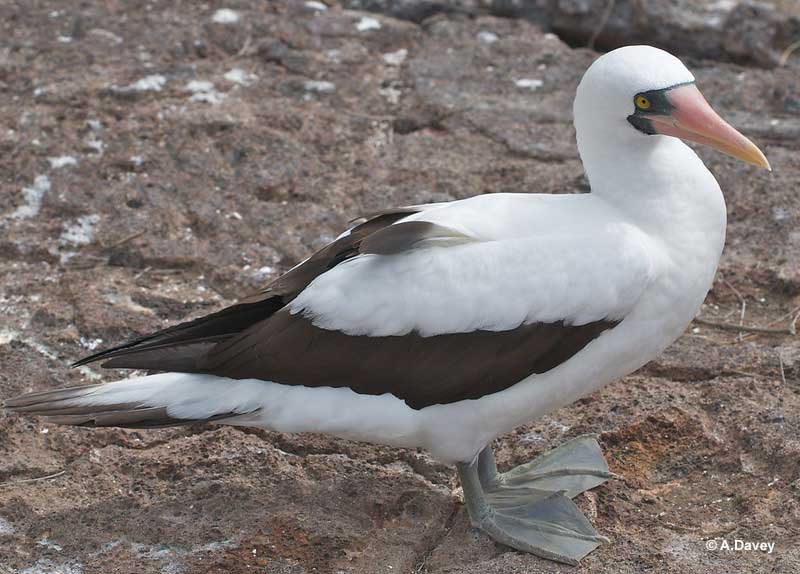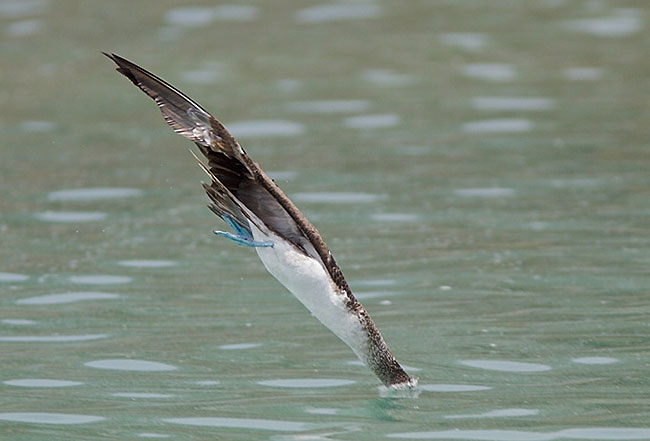
Boobies are big seabirds that make spectacular, headfirst dives into ocean waters!
Known for their tame behavior at island nesting colonies, some boobies show off their colored feet during courtship displays, and they all feed on fish and squid. Primarily birds of tropical seas, only one species is a common, regular bird in North America.
On this page
Booby Family
Boobies are ten bird species that make up the Sulidae bird family. Some birders also refer to them as “Sulids,” and all are big seabirds with long, pointed wings, wedge-shaped tails, and large, wedge-shaped beaks.
The largest booby species are the three gannets; white, goose-sized birds with black flight feathers.
In the northern Atlantic Ocean, Northern Gannets breed on sea cliffs and dive for fish in coastal waters. In southern Africa, they are replaced by the endangered Cape Gannet, and in Australia and New Zealand by the Australasian Gannet.
The other seven boobies frequent oceanic waters in various parts of the globe, including Chile and Peru, where flocks of Peruvian Boobies dive in coastal waters for anchovies and other small fish.
Further north, the Blue-footed Booby and the Nazca Booby occur from the Galapagos Islands to southern California. The other four species are birds of warm, tropical seas, one of which is the Abbot’s Booby, an endangered species that only lives on Christmas Island.
The remaining three species are seabirds that occur over a much larger area, including some parts of the USA. These birds are the Brown Booby, Masked Booby, and the Red-footed Booby.
No matter where they live, all types of boobies nest in colonies on remote islands and sea cliffs, and make similar guttural and croaking sounds.
Common Boobies in the United States
In much of the United States, it can be tough to see members of this bird family! North of southern California and southern Florida, most only occur as uncommon or rare vagrants.
However, at least three species are common breeding birds in Hawaii, and the Northern Gannet is common and easy to see on the eastern seaboard.
Related: Funny bird names that make you take another look
Northern Gannet
Morus bassanus
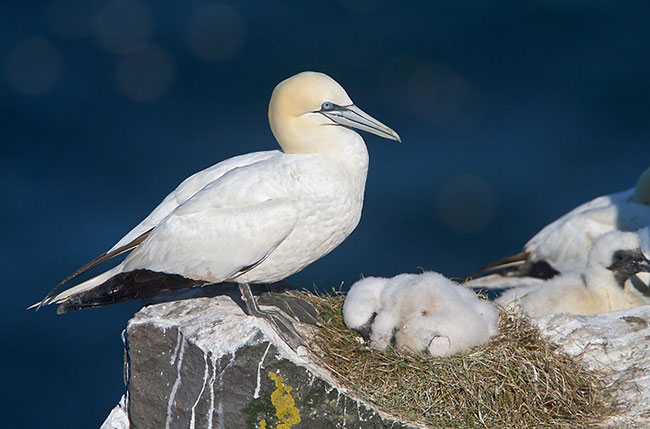
- Range: Breeds in parts of eastern Canada and northern Eurasia, and winters in coastal waters south to the Gulf of Mexico and northern Africa.
- Length: 36 inches.
Northern Gannets are big, mostly white birds with black wing tips, and blond coloration on parts of their head and the back of their neck. They also have narrow blue eyerings around their pale gray eyes, narrow black edging to the base of their hefty blue-gray beak, and black, webbed feet.
These seabirds fly with steady flaps before soaring and diving straight down into the water. Like other booby species, they often forage in flocks that plunge-dive at the same time.
Young Northern Gannets in their first year of life are dark brown-gray with a bit of white on their rump, under their wings, and have some small white speckling on their upperparts. As they get older, they have varying amounts of black and white plumage.
Like the adults, they frequent coastal waters of the Atlantic Ocean, and in the winter, can even occur in the Gulf of Mexico and the Mediterranean Sea.
Blue-footed Booby
Sula nebouxii
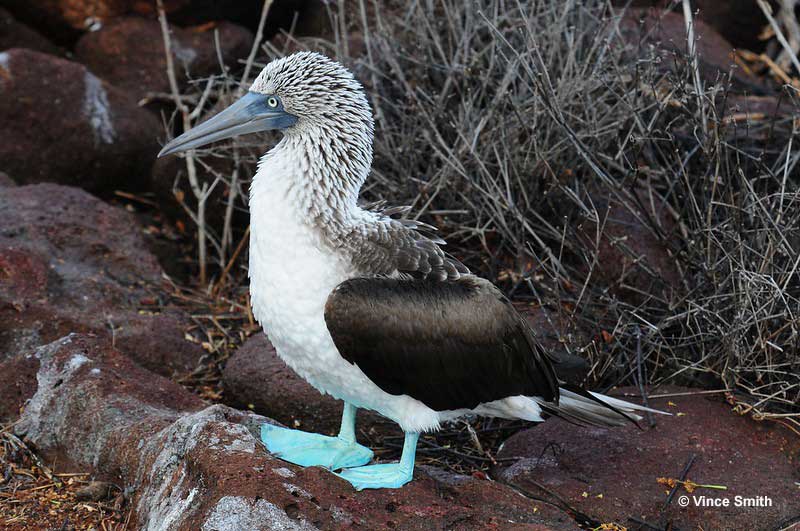
- Range: Mostly in coastal waters from the Galapagos Islands to northern Mexico, regular in southern California.
- Length: 32 inches.
Adult Blue-footed Boobies have white underparts, fine, dark streaking on their pale head, pale eyes, and a dark gray beak. The rest of their upperparts are brown-gray with white barring on their upper back, and a small white patch on their lower back.
These birds also have white in their longish tails, and bright blue legs and webbed feet. Young Blue-footed Boobies resemble adult birds but are mostly dark with a white belly. However, they always show some white on their back and tail.
This species roosts on rocky islands and flies with steady wingbeats and glides as it moves to good feeding spots. It often forms flocks but in southern California, the Blue-footed Booby typically occurs as a single, occasional visitor. One of the best spots for them is the Salton Sea.
Blue-footed Boobies prefer coastal waters, especially areas with rocky shores and islands. They can also follow boats and forage with other seabirds.
Brown Booby
Sula leucogaster
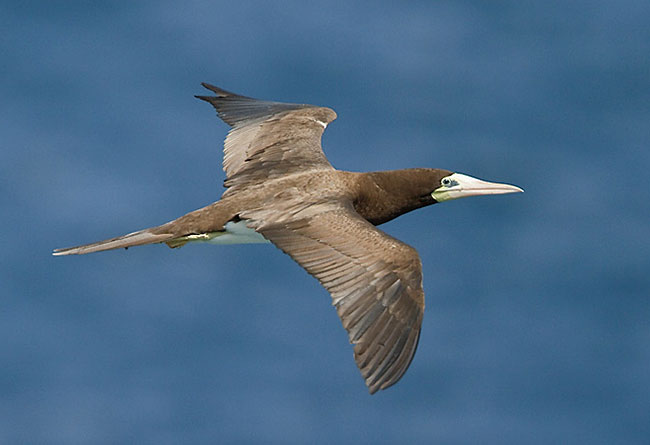
Photograph © Glenn Bartley
- Range: Tropical and subtropical seas in many parts of the world, including Hawaii. It also occurs as a regular visitor to Florida and southern California.
- Length: 30 inches
Adult Brown Boobies are big, chocolate brown seabirds with a pale yellowish beak, dark chest, and a white belly. They also have some white on their underwings, yellowish legs and webbed feet, and a pointed tail.
Like the adults, juveniles have yellowish feet but are mostly dark brown, have a dark gray beak, and are paler brown on their belly.
Brown Boobies can form flocks, but away from Hawaii, they typically occur as individuals or small groups of birds in southern California and Florida. On occasion, they also show up much further north, especially after hurricanes.
These seabirds prefer warm coastal waters where they plunge-dive for fish but can also forage quite a ways from shore. They often perch on the rigging of boats and oil drilling platforms,
Brown Boobies fly with steady flaps interspersed with glides as they search for dolphin pods and feeding opportunities where small fish are driven to the surface.
Masked Booby
Sula dactylatra
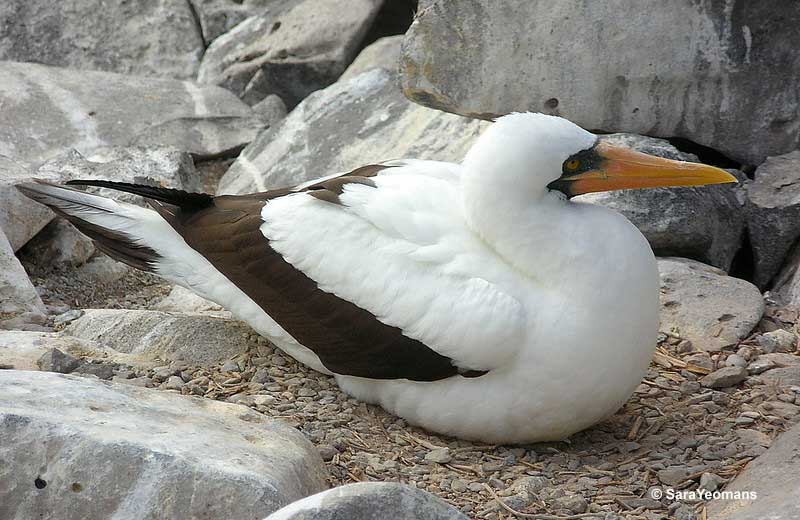
- Range: Tropical seas in many parts of the world. In the USA, mostly Hawaii, and occasionally in southern California and southern Florida.
- Length: 32 inches
The adult Masked Booby is a big, snow-white seabird with a prominent yellow or yellowish-green beak, orange eyes, and black flight feathers. It also has black in its longish, pointed tail, blackish on the base of its beak, and green-gray legs and webbed feet.
Young Masked Boobies look quite different from adults. They have a white chest, belly, and rump, and a dark brown head, pale collar, neck, tail, back, and upperwings.
This species prefers warm tropical waters, often far offshore. Once in a while, they perch on buoys and other structures near shore. Usually, though, Masked Boobies are seen foraging with other birds during pelagic trips to deep waters.
The Masked Booby flies with steady flaps and glides, and often wheels overhead before plunge-diving to catch fish and other small sea creatures. It can be on its own but usually occurs with other seabirds that forage over baitfish pushed to the surface by dolphins and big fish.
Not So Common Boobies
Nazca Booby
Sula granti
- Range: Coastal and offshore waters from the Galapagos Islands to Mexico, rarely to southern California.
- Length: 32 inches
The adult Nazca Booby looks very similar to the Masked Booby. Like that related species, it is a big, white seabird with orange eyes, and black flight feathers. It also has a long, pointed black tail, and green-gray legs and webbed feet. However, the Nazca Booby has a rose-orange beak with blackish on its base, and a yellowish tip.
Young Nazca Boobies also look like young Masked Boobies. Although it can be very difficult to separate them, young Nazca Boobies tend to have a grayish back that contrasts with their dark head, and not as much of a pale collar as the young Masked Booby.
Nazca Boobies live in warm and cool tropical waters and can be seen far out in the open ocean. They can perch on rocks and other structures near shore but are usually seen on boat trips to deep waters.
The Nazca Booby dives for fish after flying with steady flaps and glides, and often forages with other seabirds.
Peruvian Booby
Sula variegata
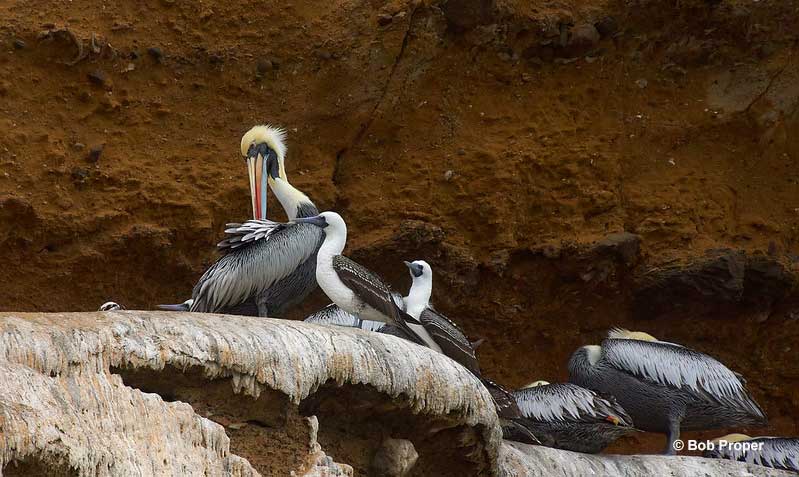
Peruvian Boobies with pelicans. © Bob Proper
- Range: Cold coastal waters of the Humboldt Current in Chile and Peru.
- Length: 29 inches
Peruvian Boobies are fair-sized, black and white seabirds with a dark grayish beak and a small black throat patch. They have some black around the base of their beak, dark eyes, and a white head, neck, and underparts.
This species also has a bit of white on the underside of its wings where they meet its body, and a bit of white in its tail. The rest of their upperparts and upperwings are dark black-brown with a bit of white speckling.
Young birds resemble adults but have dusky or dark heads and chests.
The Peruvian Booby usually occurs in flocks that forage for small fish in coastal waters. They don’t usually occur that far from shore and prefer places where they can perch on rocky islands. This species has not been seen in waters of North America and rarely ventures north of Ecuador but who knows, maybe some lucky day, it will show up in southern California!
Red-footed Booby
Sula sula
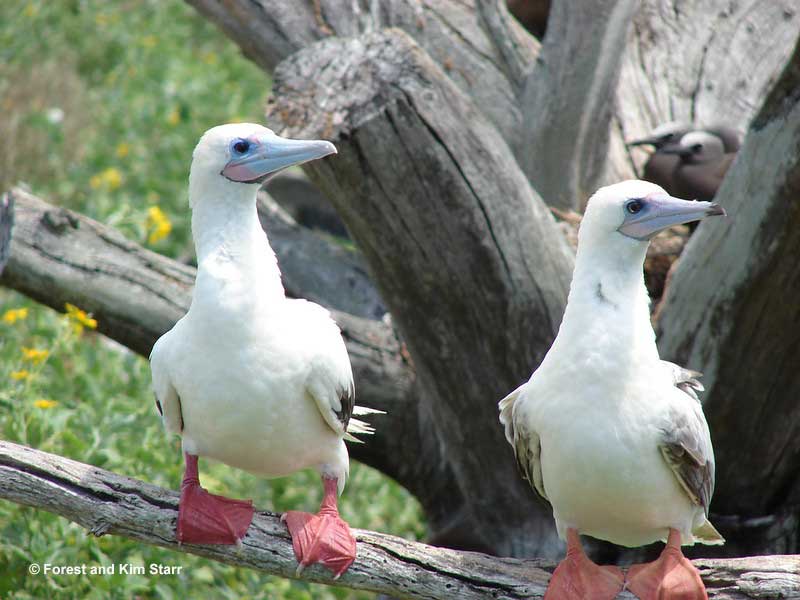
- Range: Tropical waters in many parts of the globe. A rare visitor to southern Florida and southern California.
- Length: 28 inches
Red-footed Boobies are fair-sized seabirds with red legs and webbed feet, long, pointed wings, and a longish, pointed tail. They have slightly smaller beaks than other boobies, and their bills are pale gray with some pink on the base.
These elegant seabirds also have blue around their dark eyes, and can be mostly pale brown or white with black flight feathers and blond highlights on their head. Pale brown birds have darker brown wings, and can have a dark or white tail.
White morph adult Red-footed Boobies often have some pale blond coloration on their head. Young birds are mostly dusky gray with all dark underwings, a grayish tail, and are paler on their belly.
Red-footed Boobies are quick fliers that move with steady flaps interspersed with glides. Away from breeding areas, they rarely come to shore and are usually seen on pelagic boat trips. These mostly feed on flying fish and squid.
Frequently Asked Questions
Why are they called boobies?
They are called boobies because when sailors first encountered them on their breeding grounds, they figured that the tame birds were foolish or unintelligent. So, they started referring to them as “boobies”, an antiquated term for a foolish person.
How many boobies are there?
There are ten species of boobies. This includes the gannets, three large booby species that live in the Atlantic Ocean, and around Australia and New Zealand.
What do boobies eat?
Boobies eat squid and various small fish.
Where are boobies found?
Boobies are mostly found on islands in tropical and subtropical oceans. However, the Northern Gannet lives on the eastern seaboard of Canada and the USA.
Do boobies mate for life?
Yes, most boobies mate for life.


